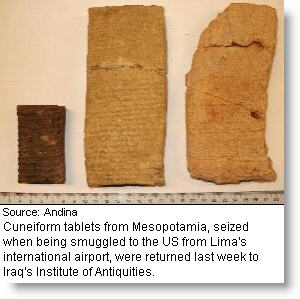Peruvian authorities and the Andean country’s National Culture Institute, INC, have been leading a campaign to stamp out the trade in antiquities illegally smuggled from Peru, reporting the seizure of more than 1,200 cultural and national heritage artifacts in 2008.
“Last year, we stopped 1,235 cultural objects from being smuggled out of Peru,” said the INC’s director, Dr. Cecilia Bákula, in comments to daily La República.
A team of three archaeologists and three art historians – on call 24 hours a day – carried out an average of 600 verifications every month, and recorded 30 seizures of artifacts.
Some of the most important pieces seized last year were not Inca or prehispanic treasures at all. Among the objects were three ancient clay tablets from Iraq, inscribed with cuneiform writing – one of the earliest known forms of written expression – and 21 macuquinas, or cobs, a crude style of irregularly shaped, hand-hammered coins, struck in Spain and colonial Spanish America. One of the Sumerian tablets was identified as originally from Babylon, south of Baghdad, and another from the region of Diyala, in southeastern Iraq. The tablets are between 4,000 and 5,000 years old.
Peru seized the ancient Mesopotamian tablets at Lima’s Jorge Chavez International Airport in February 2008, from where they were being smuggled to the United States.
The tablets were returned to Dr. Ameera Idan Hlaihel, head of Iraq’s Institute of Antiquities, last Friday.
In 2009, a new module will be integrated into Serpost, Peru’s national mail service. All replicas will have to be certified as such before they can be shipped abroad, and any object suspected or confirmed to be an antiquity will then immediately be sent to the INC’s headquarters at the Museum of the Nation in Lima.
As a member of UNESCO, Peru is committed to fight illegal trafficking of cultural heritage artifacts.
According to UNESCO, “theft, looting, illicit importation and exportation of cultural property are well-known practices, which touch first and foremost archaeological sites, religious edifices, cultural institutions and museums as well as public and private collections worldwide.”





